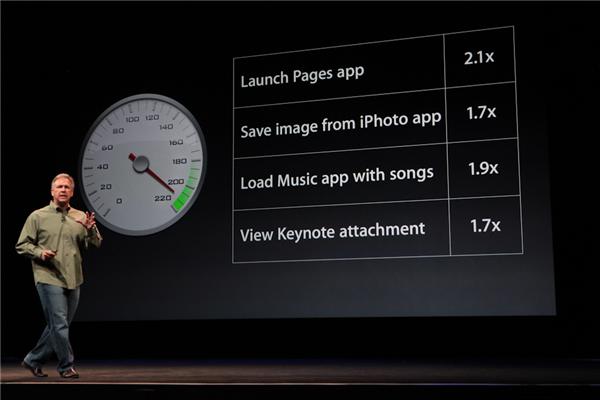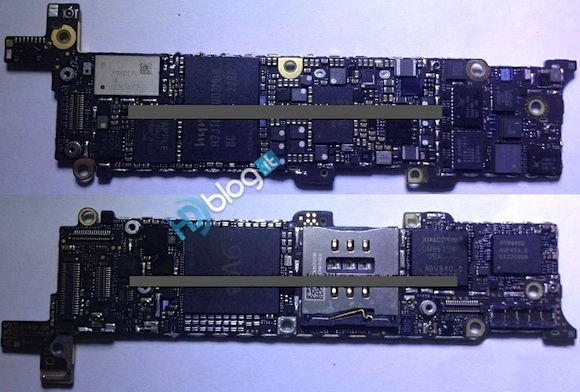Surprisingly enough, the iPhone 5 comes with Apple’s in-house A6 chip (labeled “S5L8950X”) rather than a souped up version of the A5X chip, as previously thought. Apple’s Tech Specs page for the iPhone 5 doesn’t even mention the A6 (a norm for Cupertino). The Compare iPhones page names the chip, however without divulging an iota about its architectural underpinnings.
Likewise, Apple executives at today’s presser shied away from going into the technicalities like core counts and clock speeds and would only mention a twofold jump in CPU and GPU performance. It would nonetheless appear Apple has beaten the likes of Samsung and Texas Instruments in delivering the world’s first phone powered by ARM’s Cortex A15 CPU platform…
Anand Lal Shimpi of AnandTech is well-versed in semiconductors.
Specifically, reflecting on the two times gain on the CPU side, Anand wrote:
Based on the performance gains, Apple’s history of SoC naming and some other stuff we’ve heard recently, it looks like Apple has integrated two ARM Cortex A15 cores on Samsung’s 32nm LP HK+MG process.
“This is a huge deal”, Anand explains, “because it means Apple beat both TI and Samsung on bringing A15s to market”.
True, licensees such as Nvidia, Texas Instruments, Broadcom and Samsung had previously announced forthcoming implementations, but looks like Apple beat them all to market.
The announced but not yet released products include Samsung’s Exynos 5250, Nvidia’s Tegra 4 (code-named Wayne), Broadcom’s upcoming system-on-a-chip, Texas Instruments’ OMAP5 application processor and ST-Ericsson’s Nova A9600 chip.
Samsung’s implementation in the Exynos 5 will combine two Cortex-A15 cores with two Mali GPU cores (both by ARM).
The claimed iPhone 5 logic board from this morning. Notice the big A6 chip
As you know, the previous-generation A5 chip that powers the iPhone 4S and iPad 2 is manufactured on Samsung’s 45-nanometer process, as is the A5X chip found inside the iPad 3. Both chips use ARM’s Cortex-A9 CPU core (the A4 chip from the original iPad and the iPhone 5 is based on ARM’s Cortex-A8 CPU blueprints).
ARM says that the Cortex A15 core is 40 percent faster than its Cortex-A9 counterpart.
Switching to Samsung’s 32-nanometer process and other optimizations have made possible low-power performance and a 22 percent smaller package. A good example of optimizations would be the FastCore technology that Cupertino got hold of by acquiring chip experts Intrinsity.
This acquisition has enabled Apple to tap engineering talent to develop a faster-clocked implementation of ARM’s Cortex-A8 CPU core found inside the A4 chip.
And even with the added oomph, the iPhone 5 battery run times exceed those of its predecessor, the iPhone 4S.
Per Apple, the iPhone 5 standby time is 225 hours, 25 hours more than on the iPhone 4S. Browsing time on 3G has also gone up from six hours on the iPhone 4S to eight hours on the new iPhone (on WiFi, browsing time increased from nine to ten hours).
LTE browsing time on the iPhone 5 is eight hours and talk time is the same as on the iPhone 4S.
As for the speed gain on the CPU side, this should be self-evident in everyday tasks, Apple argues: from launching apps to switching between them to a 40 percent faster photo capture to the demanding panorama mode that stitches together individual eight-megapixel images into a massive 28-megapixel panorama photo to graphics-intensive games and content creation apps such as Apple’s iMove, pictured below.
Regarding the GPU, Ananad speculates that the 2x gains “could be had through a move to 4 PowerVR SGX543 cores, up from 2 in the iPhone 4S”.
Seth Weintraub of 9to5Mac speculated back in May that Apple has “something entirely new” for the graphics subsystem:
The GPU chip, which will continue to be part of the SoC, is called “SGX543RC*” (the asterisk is another sensitive number that could identify people working on the device). This GPU technically does not exist yet and we don’t have specs.
It would appear that the A6 chip inside the iPhone 5 continues to use graphics units from fables UK-based semiconductor maker Imagination Technologies (just like the A5 and A4 variants before it). Apple likely went with the SGX543MP4 GPU, as the new iPad’s A5X.
Are you glad that the iPhone 5 comes with a much-improved processor and graphics?
How important the two times CPU/GPU speed increase is to you?


